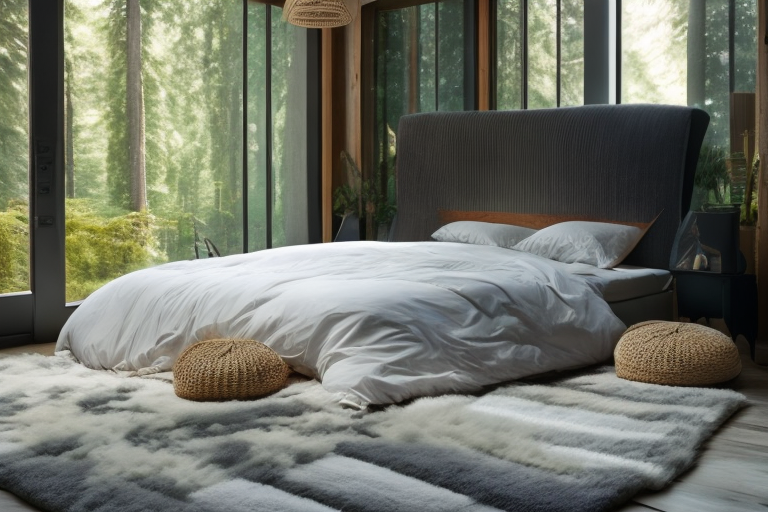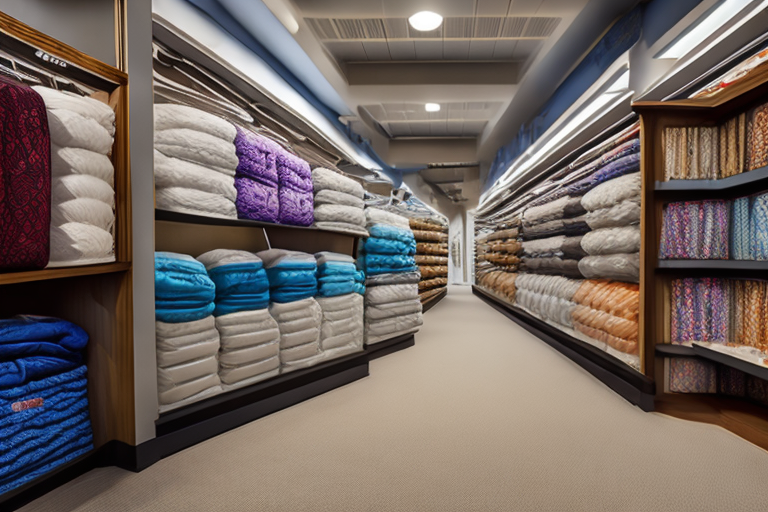Are you looking to make your bed a cozy haven with a top-quality down comforter? Getting lost in a fluffy, warm down comforter after a long day can be heavenly. But not all down comforters live up to the promise of exceptional comfort and longevity.
This beginner’s guide will teach you everything you need to confidently shop for and properly care for a down comforter. Read on to learn insider tips on identifying quality construction, understanding ethical sourcing standards, maximizing lifespan through maintenance, comparison shopping fill materials and more. We’ll also bust some common myths about down bedding.
What Makes Down So Dreamy?
Before we dive into the nitty gritty details, let’s review why down makes such a dreamy fill material in the first place:
- Incredible warmth: Down provides unbeatable insulation for its low weight and compressibility. The tiny clusters trap air to reflect body heat.
- Light and fluffy: Quality down with high fill power feels airy and soft against your skin.
- Breathability: The fill allows airflow to control your body temperature for optimal comfort.
- Long-lasting loft: Properly cared for, down maintains its lofty thickness for the long haul.
Down comforters provide welcome weight without overheating. As you cocoon in its embrace each night, you’ll be glad you invested in such a luxurious bedding upgrade.
But how do you determine which down comforters truly deliver on their promises of coziness? This guide will uncover what sets exceptional down comforters apart.
Scoping Out Quality Down Construction
Not all down comforters live up to their lofty claims of luxury. Be an informed shopper by checking for these hallmarks of enduring quality:
Fill power: This indicates the loft and insulation capacity provided per ounce of down. Most quality comforters range from 600 to 900 fill power. Higher numbers mean more warmth for less weight.
Thread count: This counts the number of threads woven together per square inch in the shell fabric. Look for thread counts between 300 and 400 for optimal breathability and durability.
Construction method:
- Baffle box style (pictured below) has fabric dividers to prevent fill shifting. This offers the most even distribution of insulation.
- Sewn-through comforters leak fill more easily. Avoid this less durable construction.
Together, these specs indicate whether you’re getting a sound long-term investment or flimsy imposter prone to premature deterioration.
Pro tip: Bring a small LED flashlight to the store to perform an easy fill-check. Shine the light at the comforter’s edge. Consistent illumination across the surface indicates reliable thickness and even fill distribution.
Now that you know what to inspect for, let’s unpack best practices for caring for your down bedding. Proper upkeep is required to achieve that decade-plus lifespan.
Caring For Your Down Comforter

Note that stuffing your down comforter into a duvet cover provides indispensable protection against body oils, sweat and other residue shortening its lifespan.
We recommend laundering your covered down comforter once every 2 years. Remove and launder just the duvet cover more frequently as needed. This avoids excessive wear and tear to the fill and shell fabric.
While professional laundering is ideal, you can safely DIY clean at home. Just be sure to use a front-loading washing machine free of agitator. Protect zippers fully, wash on delicate and skip the dryer.
Evaluating When To Replace Your Down Bedding
When is it time to upgrade your loyal down comforter to current bedding standards? Monitor these key indicators:
- The baffle boxes no longer maintain balanced fill distribution. Failing dividers lead to thin, insufficient coverage in areas.
- You regularly wake feeling too cold at night because insulation capacity has depleted. Your sleep quality suffers without reliable warmth Regulation.
- The outer fabric has become worn, frayed or sprouted small holes despite protected storage and gentle handling.
- You see visible clumping and shifting. The fill layers unevenly within compartments instead of maintaining its uniform, lightweight structure.
Failure to meet these performance standards means your down comforter has fulfilled its duty. Set aside cash for a well-deserved replacement.
Debunking Myths Around Caring For Down
Let’s tackle some prevailing myths about down comforters that often lead conscientious owners astray:
Myth: Dry cleaning is mandatory to properly clean down.
Fact: Professional dry cleaning subjects down to harsh chemicals damaging the delicate filaments over time. Laundering at cool temperatures with mild detergent sufficiently lifts most grime without added risk.
Myth: Storing down compressed ruins loft over time.
Fact: The insulation fully recovers when removed from compression, so go ahead and vacuum seal off-season comforters to optimize storage space.
Myth: Feathers make lower quality fill compared to down.
Fact: Feathers intermix well with down to create durable, lofty insulation. There is minimal actual performance difference despite common misperceptions.
Now that we’ve separated fiction from reality, let’s explore the spectrum of down types available. This will clarify choices ranging from responsibly sourced natural down through various down alternatives popular for specialized needs.
Comparing Down and Down Alternative Fills
While no synthetic alternative fully replicates genuine goose or duck down properties, synthetic fills make decent mimics. What are the differences in performance, ethics and sustainability across these options?
There are pros and cons to natural down versus manmade substitutions. Assess your priorities – ethics, safety, environmental footprint, durability, or price – and choose accordingly.
Ethical Sourcing: The Role of Down Certifications
Another key consideration as you shop is confirming your comforter fill stems from ethically treated geese and ducks. Trustworthy down undergoes audits by certification bodies like the Responsible Down Standard (RDS) organization.
Point your phone camera at a product’s hangtags or descriptions to scan for these ethical identifiers:
- Responsible Down Standard (RDS)
- DOWNMARK – audited for for humane treatment
- TrackMyDown ID number – confirms chain of custody
Tracing fill origins reassures your purchase aligns with your social values. As public awareness grows, most major brands now pursue third-party ethical verifications for down supply chains. Some even use recycled materials in shell fabrics like Oeko-Tex certified long-staple cotton.
Choosing Warmth Levels And Specialty Sizes

So you’ve weighed construction quality, ethics and care demands of prospective down comforters. Next up: selecting appropriate warmth and dimensions.
Consider your climate and whether you tend to sleep hot or cold naturally. Lightweight summer-weight comforters have lower fill power around 400-600, while winter-weight choices hover closer to 700-900 fill power.
If you reside in dynamic seasonal temps, choose an all-season middle-of-the-road fill power around 650 for flexibility. Layer blankets below to modify insulation as weather shifts.
Don’t forget to think outside the box of standard sizes like Queen and King! Indulge your inner blanket burrito by selecting an oversize Alaskan King or custom dimensions tailored to your needs. Just allow extra lead time for special order.
Ready To Pick Your Dream Down Comforter?
We hope this down comforter beginner buying and care guide erases any remaining confusion. You now hold the blueprint for scouting enduring quality backed by ethical sourcing standards. Follow best practices for maximizing lifespans through proper maintenance as well.
Here are key takeaways to guide your journey from showroom to dreamy at-home oasis:
Quality indicators: Fill power, thread count, baffle box construction
Realistic lifespan: 10-15 years with proper care
Care best practices: Wash every 2 years, air dry, use duvet cover
Replacement clues: Thin spots, cooling, clumped fill
Ethical down certifications: RDS, DOWNMARK
With this knowledge foundation cementing realistic expectations, you are ready to pinpoint “the one” down comforter assuring countless nights of cozy comfort. Just be sure to set aside budget for a replacement within the next decade as general wear and tear takes its toll. But in the meantime, rest easy!
As you drift off, cocooned in downy insulation each evening, remember we’re always here to answer any lingering questions about your newest bedding staple. Here’s to many wonderful years nuzzling under your investment quality comforter counting sheep. Pleasant dreams!
Frequently Asked Questions
Still hunger for more down comforter knowledge? These common FAQs should satisfy any remaining curiosity:
What’s the ideal washing frequency for down comforters?
Every 2 years suffices for protected comforters used with duvet covers. Wash duvet covers more often as they collect most grime.
How do I add extra warmth to a lightweight summer down comforter?
Simply layer seasonal blankets below your comforter when cooler weather arrives. Choosing middle fill power around 650 allows for flexible layering.
What’s the benefit of baffle box construction?
The baffle boxes (interior fabric walls) rein in fill to prevent shifting and maintain consistent insulation coverage across the comforter surface.
How do I know if my down comforter needs replacing?
Inspect closely for bald spots, intolerable cooling at night indicating depleted fill and baffle boxes that no longer contain the fill distribution.
Can I put a down comforter in a duvet cover by myself?
Yes! Just lay the cover flat, place your comforter inside and start rolling it closed from one side to the other before unfurling upwards. Shake into place.
What certifications should I look for ethical sourcing?
Key indicators of humane down production include Responsible Down Standard (RDS) and DOWNMARK confirmations audited and verified by independent testing laboratories.








